
Welcome to Hyperion Records, an independent British classical label devoted to presenting high-quality recordings of music of all styles and from all periods from the twelfth century to the twenty-first.
Hyperion offers both CDs, and downloads in a number of formats. The site is also available in several languages.
Please use the dropdown buttons to set your preferred options, or use the checkbox to accept the defaults.

| Vasari Singers, Jeremy Backhouse (conductor), Jeremy Filsell (organ)» More |
| Houston Chamber Choir, Robert Simpson (conductor), Ken Cowan (organ)» More |
| King's College Choir Cambridge, Orchestra of the Age of Enlightenment, Sir Stephen Cleobury (conductor)» More |
| Corydon Singers, English Chamber Orchestra, Matthew Best (conductor)» More |
| Westminster Cathedral Choir, James O'Donnell (conductor)» More |
| The Choir of Trinity College Cambridge, Harrison Cole (organ), Stephen Layton (conductor)» More |

It could be that the idea of basing a Requiem on plainsong melodies indeed came initially from Tournemire, who as organist of Sainte-Clotilde rarely played set voluntaries, preferring to put on the desk the page of the Liber Usualis (the standard collection of plainsong chants) containing the chant for the day, and to improvise on it. Duruflé later remembered these occasions vividly: ‘Tournemire found in Sainte-Clotilde’s magnificent Cavaillé-Coll organ the ideal instrument, one which responded wonderfully to his every wish, to the flights of his imagination—by turns poetic, picturesque, whimsical; then impetuous, tumultuous, wild; finally peaceful, mystical, blissful. He generally preferred blissful conclusions.’ The impact of these experiences can be readily felt in his own Requiem, in the similarly wide emotional range and in the blissful conclusion.
That said, the work’s progress was far from straightforward. At some unspecified point, but almost certainly very early in World War II, Duruflé was writing a suite for organ on plainsong themes, but came to realize that it was difficult to separate the music from the texts it set. As he wrote: ‘The marvellous Gregorian line and the Latin text take on a suppleness and a lightness of expression, a reserve and an ethereal gentleness that free it from the compartmentalization of our bar lines.’ He also cherished the irregular alternation of duplet and triplet rhythms. Then, in May 1941, he was commissioned by the Vichy government to write a symphonic poem. In some way that is surprising to say the least, he managed, in 1948 with the Requiem completed, to persuade the state to accept it in place of a symphonic poem; and where Vichy’s initial fee had been 10,000 francs, the post-war government paid him 30,000. Although the dedication is ‘to the memory of my father’, who had died in 1945, the composer’s biographer James E Frazier is surely right in claiming that the work ‘was heard by his countrymen in 1947 as an obsequy for France’.
It has been generally claimed that one of the main influences on the work was the Requiem by Fauré, so it’s as well to quote Duruflé on the subject: ‘I do not think I was influenced by Fauré, contrary to the opinion of certain music critics who, anyway, have never given any explanation for their point of view. I have simply tried to surround myself with the style suitable to the Gregorian chants as well as the rhythmic interpretation of the Benedictines of Solesmes.’ Duruflé was the kindest and most peaceful of men, but clearly these critics touched on a sore point. In fact, there’s a strong case for saying that the similarities between the Fauré and Duruflé settings are too numerous to be accidental: the texts chosen are almost exactly the same, with the ‘Pie Jesu’ extracted from its proper place at the end of the ‘Dies irae’, and the ‘Libera me’ and the ‘In paradisum’ borrowed from the Burial Service. Both composers use a baritone soloist in the ‘Domine Jesu Christe’ and the ‘Libera me’, and a female soloist in the ‘Pie Jesu’ … and the similarities do not end there.
Duruflé’s musical language, like Fauré’s, owes much to the church modes, conforming with the cast of the plainsong melodies themselves, but one of the most impressive features of this powerfully emotional work is the way in which he ‘develops’ plainsong themes according to his own inspiration, while certainly his harmonies do go beyond Fauré’s in their modernity—hardly surprising given the fifty-seven years that separated the two composers. Duruflé time and again finds ways of marrying his age-old material with this more recent compositional technique, and even manages to make the chromatic elements of his basically modal harmony sound natural.
Sometimes he will begin with a strict enunciation of plainsong, as in the first sung entry of the Introït, but then continue freely, while pursuing the plainsong in another part. Sometimes he will start strictly, but then break entirely free, as in the huge climax of the Kyrie, or at the beginning of the ‘Domine Jesu’, where the introduction is strict, but the female voices then develop the initial idea. Frequently he will alter the pitch relationships between the various limbs of a plainsong melody or, as in the Agnus Dei, organize them polyphonically, with the same phrase heard simultaneously in different parts at different pitches. Tellingly, in the ‘In paradisum’ the plainsong theme is heard unchanged, first in the choir, then in the organ, as if to remind us that paradise has no place for ‘development’, life within it being unimprovable.
Finally, we may note that Duruflé was never satisfied with what he had written, and was quick to seek advice. One source was Nadia Boulanger, and after she had congratulated him on a performance of the Requiem in 1957, he could still write to her of his ‘gratitude for the wonderful advice you gave me at the time when I was working with difficulty on this music. It is indeed thanks to you that I was able to overcome my problems.’ On the other hand, when another supporter, Marcel Dupré, was asked his opinion of the Requiem, all he could say was: ‘This music is perfect.’
Duruflé made three versions of the Requiem: with organ and large orchestra (1947); with organ (1948), the version recorded here; and with organ and small orchestra (1961). The work was first performed in a Radio France broadcast on 2 November 1947 (All Souls’ Day), conducted by Roger Désormière, with Hélène Bouvier and Camille Maurane singing the solo parts. The first public performance took place on 28 December of the same year, with Paul Paray conducting the Colonne Orchestra; Hélène Bouvier was again the female soloist, partnered by Charles Cambon. The British premiere was given in 1952 by the City of Birmingham Choir and Orchestra in Birmingham Town Hall, conducted by David Willcocks.
from notes by Roger Nichols © 2024
L’idée de baser un Requiem sur des mélodies de plain-chant lui serait peut-être venue, au départ, de Tournemire qui, comme organiste de Sainte-Clotilde jouait rarement des morceaux d’orgue déterminés, préférant mettre sur le pupitre le Liber Usualis (le recueil de référence de mélopées de plain-chant) ouvert à la page du jour, et d’improviser sur celui-ci. Duruflé se remémora plus tard ces occasions avec précision: «Tournemire avait trouvé dans le magnifique Cavaillé-Coll de Sainte-Clotilde l’instrument idéal, celui qui répondait merveilleusement à ses sollicitations, aux élans de son imagination tour à tour poétique, pittoresque, capricieuse, puis passionnée, tumultueuse, déchaînée puis apaisée, mystique, extatique … Il préférait généralement une fin dans la douceur et l’extase.» On peut aisément trouver trace de ces expériences dans son propre Requiem, dans la portée émotionnelle tout aussi large et dans la conclusion extatique.
Ceci dit, la progression de l’œuvre fut loin d’être simple. À un moment indéterminé, mais très certainement au tout début de la Seconde Guerre mondiale, Duruflé était en train d’écrire une suite pour orgue sur des thèmes de plain-chant; mais il en vint à réaliser qu’il était difficile de séparer la musique des textes qu’elle illustrait. Comme il l’écrivit: «La merveilleuse ligne grégorienne et le texte latin prennent une souplesse et une légèreté d’expression, une retenue et une douceur immatérielle qui la libèrent du cloisonnement de nos barres de mesures.» Il chérissait aussi l’alternance irrégulière des rythmes binaire et ternaire. Puis, en mai 1941, le gouvernement de Vichy lui commanda un poème symphonique. D’une certaine façon, ce qui est pour le moins surprenant, en quelque sorte, c’est qu’il réussit, en 1948, à convaincre l’État d’accepter le Requiem achevé à la place du poème symphonique; et alors que les honoraires prévus étaient de dix mille francs, le gouvernement de l’après-guerre lui en donna trente mille. Malgré la dédicace «à la mémoire de mon père», qui était mort en 1945, le biographe du compositeur, James E Frazier, a sûrement raison en affirmant que cette œuvre «fut entendue par ses compatriotes en 1947 comme des funérailles pour la France».
On a souvent affirmé que l’une des principales influences exercées sur cette œuvre était le Requiem de Fauré; il vaut donc mieux citer Duruflé à ce sujet: «Je ne pense pas avoir été influencé par Fauré, contrairement à ce que pensent certains critiques musicaux qui, de toute façon, n’ont jamais donné la moindre explication de leur point de vue. J’ai simplement essayé de m’entourer du style adapté aux chants grégoriens ainsi qu’à l’interprétation rythmique des Bénédictins de Solesmes.» Duruflé était le plus aimable et le plus paisible des hommes, mais manifestement ces critiques touchèrent un point délicat. En fait, il y a de bonnes raisons de dire que les similitudes entre le Requiem de Fauré et celui de Duruflé sont trop nombreuses pour être fortuites: les textes choisis sont presque exactement les mêmes, avec le «Pie Jesu» extrait de sa place habituelle à la fin du «Dies irae», et le «Libera me» et l’«In paradisum» empruntés à l’office des morts. Les deux compositeurs utilisent un soliste baryton dans le «Domine Jesu Christe» et le «Libera me», et une soliste dans le «Pie Jesu» … et les similitudes ne s’arrêtent pas là.
Le langage musical de Duruflé, comme celui de Fauré, doit beaucoup aux modes d’église, se conformant au moule des mélodies de plain-chant elles-mêmes, mais l’une des caractéristiques les plus impressionnantes de cette œuvre fortement émotionnelle c’est la manière dont Duruflé «développe» les thèmes de plain-chant selon sa propre inspiration, alors que ses harmonies vont certainement bien au-delà de celles de Fauré dans leur modernité—ce qui n’est guère surprenant étant donné les cinquante-sept ans qui séparaient les deux compositeurs. À de multiples reprises, Duruflé trouve des manières de marier son matériel séculaire avec cette technique de composition plus récente, et réussit même à faire paraître naturels les éléments chromatiques de cette harmonie fondamentalement modale.
Il commence parfois avec une énonciation stricte du plain-chant, comme dans la première entrée chantée de l’Introït, mais il continue ensuite librement, tout en poursuivant le plain-chant dans une autre partie. Il débute parfois rigoureusement, mais s’échappe ensuite totalement, comme dans l’immense sommet du Kyrie, ou au début du «Domine Jesu», où l’introduction est stricte, mais où les voix féminines développent ensuite l’idée initiale. Il modifie souvent les relations de tessiture entre les diverses parties d’une mélodie de plain-chant ou, comme dans l’Agnus Dei, les organise de manière polyphonique, avec la même phrase entendue simultanément dans différentes parties à des hauteurs différentes. Fait révélateur, dans l’«In paradisum», le thème de plain-chant reste inchangé, tout d’abord au chœur, puis à l’orgue, comme pour nous rappeler que le paradis n’avait pas de place pour le «développement», la vie en son sein ne pouvant être améliorée.
Enfin, on peut noter que Duruflé n’était jamais satisfait de ce qu’il avait écrit et il n’hésitait pas à chercher des conseils, notamment auprès de Nadia Boulanger. Une fois qu’elle l’eut félicité à propos d’une exécution du Requiem en 1957, il put encore lui écrire «sa reconnaissance pour les merveilleux conseils que vous m’avez donnés au moment où je travaillais péniblement à cette musique. C’est bien grâce à vous si j’ai pu arriver au bout de mes peines.» Par ailleurs, lorsqu’on demanda à Marcel Dupré, un autre sympathisant, ce qu’il pensait du Requiem, tout ce qu’il put dire fut: «Cette musique est parfaite.»
Duruflé fit trois versions du Requiem: avec orgue et grand orchestre (1947); avec orgue (1948), la version enregistrée ici; et avec orgue et petit orchestre (1961). L’œuvre fut créée lors d’une émission à la Radiodiffusion française le 2 novembre 1947 (le Jour des Morts), sous la direction de Roger Désormière, avec Hélène Bouvier et Camille Maurane qui chantaient les parties solistes. La première exécution publique eut lieu le 28 décembre de la même année, avec Paul Paray à la tête de l’Orchestre Colonne; Hélène Bouvier était encore la soliste et faisait équipe avec Charles Cambon. La première exécution britannique fut donnée en 1952 par le Chœur et l’Orchestre de la Ville de Birmingham à l’Hôtel de ville de Birmingham, sous la direction de David Willcocks.
extrait des notes rédigées par Roger Nichols © 2024
Français: Marie-Stella Pâris
Es ist möglich, dass die Idee, ein Requiem auf Cantus-planus-Melodien zu basieren, in der Tat ursprünglich von Tournemire stammte, der als Organist von Sainte-Clotilde nur selten auskomponierte Orgelvorspiele vortrug und stattdessen lieber die entsprechende Seite des Liber Usualis (die Standard-Sammlung von Chorälen) mit dem jeweiligen Tageschoral aufschlug, um dann darüber zu improvisieren. Duruflé erinnerte sich später lebhaft an derartige Anlässe: „Tournemire fand in der herrlichen Cavaillé-Coll-Orgel von Sainte-Clotilde das ideale Instrument vor: eine Orgel, die in wunderbarer Weise auf alle seine Wünsche und Höhenflüge reagierte—abwechselnd poetisch, malerisch, launisch, dann ungestüm, stürmisch, wild, und schließlich friedlich, mystisch, glückselig. Im Allgemeinen bevorzugte er glückselige Abschlüsse.“ Die Auswirkungen dieser Erfahrungen lassen sich im Requiem mit seiner ähnlich großen emotionalen Bandbreite und dem seligen Schluss nachvollziehen.
Dennoch war die Entwicklung des Werks alles andere als geradlinig. Zu einem nicht näher bezeichneten Zeitpunkt, allerdings höchstwahrscheinlich zu Beginn des Zweiten Weltkriegs, schrieb Duruflé eine Orgelsuite über Choralthemen, musste aber feststellen, dass es schwierig war, die Musik von den vertonten Texten zu trennen. Er schrieb: „Die wunderbare gregorianische Linie und der lateinische Text erhalten eine Geschmeidigkeit und eine Leichtigkeit des Ausdrucks, eine Zurückhaltung und eine ätherische Sanftheit, die sie von der Aufteilung unserer Taktstriche befreien.“ Er schätzte auch den unregelmäßigen Wechsel von Zweier- und Dreierrhythmen. Im Mai 1941 erhielt er dann von der Vichy-Regierung den Auftrag, eine symphonische Dichtung zu schreiben. Erstaunlicherweise gelang es ihm 1948, als das Requiem fertiggestellt war, den Staat davon zu überzeugen, dieses anstelle einer symphonischen Dichtung zu akzeptieren; und während das ursprüngliche Vichy-Honorar 10.000 Francs betragen hatte, zahlte ihm die Nachkriegsregierung 30.000. Obwohl die Widmung lautet „zum Andenken an meinen Vater“, der 1945 verstorben war, hat der Biograph des Komponisten, James E. Frazier, sicher Recht, wenn er behauptet, dass das Werk „1947 von seinen Landsleuten als Trauerfeier für Frankreich aufgefasst wurde“.
Man geht im Allgemeinen davon aus, dass ein wichtiger Einfluss auf das Werk das Requiem von Fauré war; Duruflé selbst äußerte sich dazu folgendermaßen: „Ich glaube nicht, dass ich von Fauré beeinflusst wurde, im Gegensatz zur Meinung einiger Musikkritiker, die im Übrigen nie eine Erklärung für ihren Standpunkt abgegeben haben. Ich habe einfach versucht, mich mit dem Stil zu umgeben, der den gregorianischen Gesängen und der rhythmischen Interpretation der Benediktiner von Solesmes entspricht.“ Duruflé war ein äußerst freundlicher und friedlicher Mensch, doch hatten diese Kritiker offensichtlich einen wunden Punkt berührt. Tatsächlich finden sich so viele Ähnlichkeiten zwischen den Vertonungen von Fauré und Duruflé, dass sie kaum zufällig zu sein scheinen: die gewählten Texte sind fast identisch, wobei das „Pie Jesu“ von seinem eigentlichen Platz am Ende des „Dies irae“ entfernt wurde und das „Libera me“ und das „In paradisum“ aus dem Begräbnisgottesdienst übernommen wurden. Beide Komponisten setzen im „Domine Jesu Christe“ und im „Libera me“ einen Bariton-Solisten ein, im „Pie Jesu“ eine weibliche Solostimme … und damit enden die Parallelen noch nicht.
Duruflés musikalische Sprache ist, ebenso wie die Faurés, stark an den Kirchentonarten orientiert und passt sich an die Gestalt der Choral-Melodien selbst an. Eines der beeindruckendsten Merkmale dieses kraftvoll-emotionalen Werks ist jedoch die Art und Weise, in der er die Choral-Themen gemäß seiner eigenen Inspiration „durchführt“, während seine Harmonien in ihrer Modernität sicherlich über die Fauré’schen hinausgehen—was angesichts der 57 Jahre, welche die beiden Komponisten trennen, kaum überrascht. Duruflé findet immer wieder Wege, sein altes Material mit dieser neueren Kompositionstechnik zu verbinden, und er schafft es sogar, die chromatischen Elemente seiner grundsätzlich modalen Harmonik natürlich klingen zu lassen.
Manchmal beginnt er mit einer präzisen Wiedergabe des Chorals, wie etwa im ersten gesungenen Teil des Introït, fährt dann aber frei fort, während er den Choral in einer anderen Stimme weiterführt. Manchmal beginnt er strikt, und löst sich dann völlig, wie bei dem großen Höhepunkt des Kyrie oder zu Beginn des „Domine Jesu“, wo die Einleitung strikt gehalten ist, die Frauenstimmen dann aber das Anfangsmotiv weiterentwickeln. Häufig verändert er die Tonhöhenverhältnisse zwischen den verschiedenen Gliedern einer Choral-Melodie oder ordnet sie, wie im Agnus Dei, polyphon an, wobei dieselbe Phrase gleichzeitig in verschiedenen Stimmen in unterschiedlichen Tonhöhen erklingt. Bezeichnenderweise erklingt im „In paradisum“ das Choral-Thema unverändert, zuerst im Chor, dann in der Orgel, als wolle es uns daran erinnern, dass im Paradies kein Platz für „Weiterentwicklung“ ist, da das Leben dort nicht mehr verbessert werden kann.
Abschließend sei angemerkt, dass Duruflé nie mit dem zufrieden war, was er geschrieben hatte, und schnell um Rat bat. Eine Quelle dafür war Nadia Boulanger, und nachdem sie ihm 1957 zu einer Aufführung des Requiems gratuliert hatte, konnte er ihr noch seine „Dankbarkeit aussprechen für die wunderbaren Ratschläge, mit denen Sie mir zur Seite standen, als ich mich mit dieser Musik schwertat. Es ist in der Tat Ihr Verdienst, dass ich meine Probleme überwinden konnte.“ Als ein weiterer seiner Unterstützer, Marcel Dupré, jedoch nach seiner Meinung zu dem Requiem gefragt wurde, konnte er nur sagen: „Diese Musik ist perfekt.“
Duruflé fertigte drei Versionen des Requiems an: die erste für Orgel und großes Orchester (1947), die zweite, hier eingespielte für Orgel (1948) und die dritte für Orgel und kleines Orchester (1961). Das Werk wurde am 2. November 1947 (Allerseelen) in einer Sendung von Radio France unter der Leitung von Roger Désormière uraufgeführt, wobei Hélène Bouvier und Camille Maurane die Solopartien sangen. Die erste öffentliche Aufführung fand am 28. Dezember desselben Jahres unter der Leitung von Paul Paray mit dem Orchester Colonne statt; Hélène Bouvier war wiederum die Solistin und trat zusammen mit Charles Cambon auf. Die britische Premiere wurde 1952 von dem City of Birmingham Orchester und Chor in der Birmingham Town Hall unter der Leitung von David Willcocks gegeben.
aus dem Begleittext von Roger Nichols © 2024
Deutsch: Viola Scheffel
 Hyperion sampler - March 2024 Vol. 2 Hyperion sampler - March 2024 Vol. 2 |
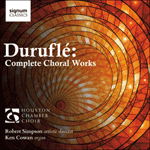 Duruflé: Complete Choral Works Duruflé: Complete Choral WorksA debut Signum recording from the Houston Chamber Choir presents the complete choral output of Maurice Duruflé, compositions as carefully crafted as they are infused with the Gregorian traditions of the distant French past to which their composer ...» More |
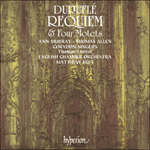 Duruflé: Requiem & Four Motets Duruflé: Requiem & Four Motets‘For my money, remains the finest recorded version of this lovely work in any of its guises … strongly recommended’ (Gramophone) ‘The perfect team of soloists, a glorious sound from both choir and orchestra, a faithful re-creation of the score, and that special something which t ...» More |
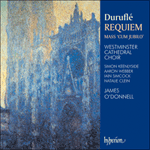 Duruflé: Requiem & Messe Cum jubilo Duruflé: Requiem & Messe Cum jubilo‘O'Donnell's achievement becomes the reference point against which future recordings of this repertoire are measured’ (Choir & Organ) ‘The Westminster Cathedral boys and men carry the lyricism and harmonic luxuriance to an ethereal plane. The choral singing is superb … helping o ...» More |
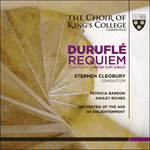 Duruflé: Requiem & other choral works Duruflé: Requiem & other choral worksKing’s College Choir joins with the Orchestra of the Age of Enlightenment and soloist Patricia Bardon in a wonderful new recording of Duruflé's Requiem.» More |
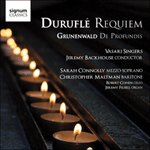 Duruflé: Requiem; Grunenwald: De profundis Duruflé: Requiem; Grunenwald: De profundis'Jeremy Filsell has clearly studied Duruflé’s orchestral versions and pulls out whatever stops necessary on the Tonbridge School organ to recreate the ...  Musical Opinion» More Musical Opinion» More |
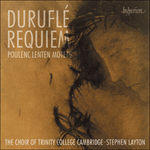 Duruflé: Requiem; Poulenc: Lenten Motets Duruflé: Requiem; Poulenc: Lenten MotetsA superlative new account of Duruflé’s evergreen Requiem from the Trinity College Cambridge forces and their illustrious out-going Director of Music. With the addition of Poulenc’s austerely beautiful motets ‘pour un temps de pénitence’, this rele ...» More |
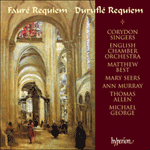 Fauré & Duruflé: Requiem Fauré & Duruflé: Requiem‘Superb’ (Fanfare, USA)» More |
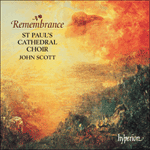 Remembrance Remembrance‘A lasting souvenir of a moving occasion, a fitting tribute to a great man, but above all, fine listening’ (Gramophone)» More |
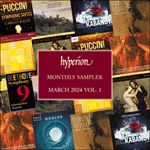 Hyperion sampler - March 2024 Vol. 1 Hyperion sampler - March 2024 Vol. 1 |

